International Journal of
eISSN: 2574-8084


Case Report Volume 2 Issue 6
Department of Radiology, China
Correspondence: Chung Kuao Chou, Department of Radiology, Yuans General Hospital, No. 162, Cheng-Kung 1 st. Rd, Kaohsiung, Taiwan, Republic of China, Tel 886-7-3351121
Received: October 31, 2017 | Published: April 19, 2017
Citation: Chou CK. Internal hernia of the small bowel through the sigmoid mesocolon. Int J Radiol Radiat Ther. 2017;2(6):142-144. DOI: 10.15406/ijrrt.2017.02.00044
A pre-operative diagnosis of an internal hernia of the small bowel through a defect of the sigmoid mesocolon is presented. The computed tomography (CT) demonstrated that the herniated small bowel traversed dorsal to the sigmoid colon to left lower abdomen, just like undermining through the sigmoid mesocolon. The CT findings and an illustrated figure corresponding to the CT pictures will be shown. A condition with similar appearance without hernia will also be described.
Keywords: internal hernia, transmesocolic hernia, ct
PSB, proximal small bowel; HER, herniating point; PHSB, proximal herniated small bowel; DC, descending colon; PSC, proximal sigmoid colon; DSC, distal sigmoid colon; DHSB, distal herniated small bowel; P, psoas muscle; HSB, herniated small bowel; SB, small bowel
Sigmoid-related hernia indicates small bowel protrusion either into the intersigmoid fossa (intersigmoid type), through a defect of the sigmoid mesocolon (transmesocolic type), or into the mesocolon itself (intramesocolic type) to left lower abdomen.1‒3 On CT, the herniated small bowel loops lie posterior and lateral to the sigmoid colon. The defect is located between the sigmoid colon and left psoas muscle or between the sigmoid loops.2,3 In the current report, beside the characteristic CT manifestations of transmesocolic hernia, another condition with similar relationship of the small bowel and sigmoid colon on axial images without hernia will also be discussed.
A 55year-old male consulted to our emergency department with the complaint of a sudden-onset upper abdominal pain at about 6pm today. The routine blood and biochemical data were non-specific. He was just discharged from the surgical ward of our hospital after a laparoscopic partial descending colectomy for colonic carcinoma 11days ago. About 12cm long descending colon was resected. The pTNM stage was T1N0M0 and clinical stage I. An emergent CT examination demonstrated a long small bowel segment traversing dorsal to the sigmoid colon to left lower abdomen (Figures 1A‒1C & 2A‒2C). The proximal small bowel was dilated and abruptly narrowed, with a beak-like or triangular-shape appearance, at a site dorsal to the rational course of the sigmoid colon. It seemed that this segment was undermining through a hole in the sigmoid mesocolon. The associated mesenteric vessels also showed a converging appearance like they were passing through a tunnel on the coronal images (Figure 2A‒2C). Under the impression of internal hernia of the small bowel through the sigmoid mesocolon (transmesocolic hernia), the patient was admitted to receive further treatment. Because of progression of abdominal distension, a second laparoscopic operation was performed 5days later. During operation, a long small bowel segment herniated through a defect, which was about 10cm long, of the sigmoid mesocolon was noted. The small bowel proximal to the herniation was dilated, consistent with clinical presentation of obstruction. The herniated small bowel was pulled back without irreversible damage and the defect repaired. The patient recovered uneventfully and discharged 1week later after operation.
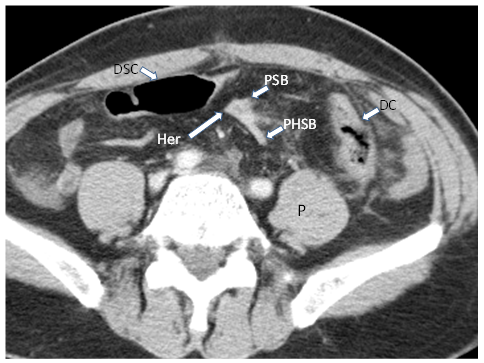
Figure 1A Post-contrast axial image. The proximal small bowel (PSB) at the herniating point (her) assumed a beak- or triangular-shape and continued to proximal herniated small bowel (PHSB). It was located dorsal to proximal sigmoid colon (shown on 1B) which was connected to descending (DC) and distal sigmoid colon (DSC). P-psoas muscle.
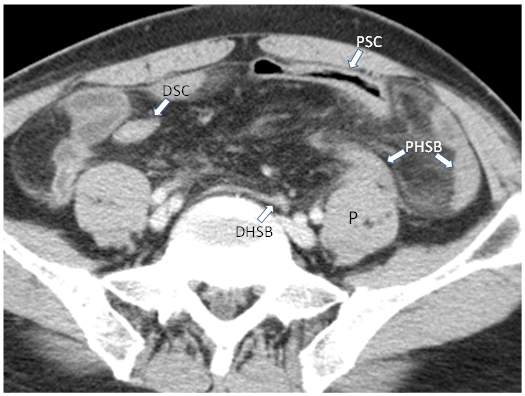
Figure 1B Axial image at a level 2cm caudal to 1A. The proximal sigmoid colon (PSC) lay in front of the proximal (PHSB) and distal (DHSB) herniated small bowel. DSC-distal sigmoid colon. P-psoas muscle.
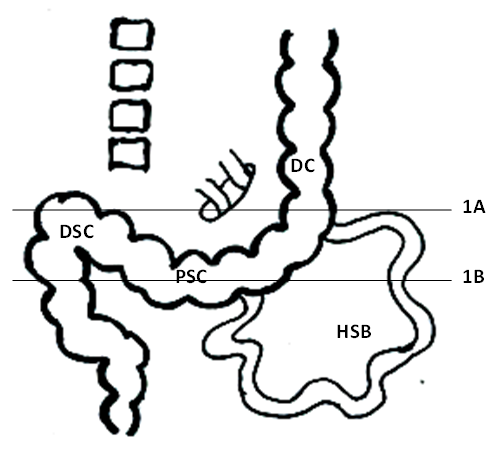
Figure 1C A diagram shows two levels, straight lines 1A and 1B, corresponding to images levels shown in Fig. 1A and 1B. HSB-herniated small bowel.
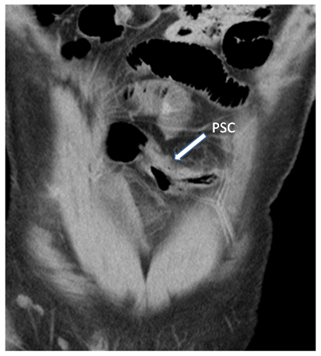
Figure 2A Reformatted coronal image. The most anterior image showed the anteriorly displaced proximal sigmoid colon (PSC).

Figure 2B An image 15mm posterior to Fig. 2A showed the beak-like or triangular-shaped herniating point (Her), descending colon (DC), distal sigmoid colon (DSC), and fan-distributed herniated small bowel (HSB). The herniating point was posterior to the proximal sigmoid colon shown on Fig. 2A. The herniated small bowel mesentery showed edematous appearance.
Internal hernia is protrusion of the viscera through normal or abnormal apertures into another compartment of the abdominal cavity. These apertures include normal foramina, recesses or fossae; congenital, surgery- or trauma-induced defect; or adhesion-induced foramen.1‒3 Its clinical presentations include nausea, vomiting, mild to severe abdominal pain, and abdominal distension. The outcomes range from spontaneous recovery, obstruction, to catastrophic bowel necrosis. The common CT appearances of internal hernias include two closely opposed ends of a dilated small bowel segment, radially distributed U- or C-shaped bowel loops, vascular convergence, special relationship of the splanchnic vessels and adjacent bowels, and a circumscribed mass or special location of the herniated small bowel.2‒11
Among these internal hernias, the sigmoid-related hernia occupies about 6%.3 The characteristic CT findings of this hernia is protrusion of the small bowel loops between the sigmoid colon and left psoas muscle to lie posterior and lateral to the sigmoid colon on the transverse plane.2,3 However, the small bowel may lie in a similar location on axial images of CT without transmesocolic hernia (Figure 3A‒3C). In most conditions, the retroperitoneal descending colon is anchored parallel to the vertebral column on lateral side of retroperitoneum by the dorsal parietal peritoneum, and the intraperitoneal sigmoid mesocolon anchored obliquely on infero-lateral side of the retroperitoneum. Thus the small bowel always lies anterior and medial to the descending-sigmoid colon. However, the descending colon is not uncommonly found to move close to the midline and the sigmoid colon is dragged to right lower abdomen. In that circumstance, the small bowel may overlie in front of the descending-sigmoid colon to left lower abdomen and locate posterior and lateral to the sigmoid colon on the axial images, mimicking that of transmesocolic hernia. The critical difference between these two conditions is that the small bowel traverses dorsal to the sigmoid colon in transmesocoilic hernia. In the present case, by following the images sequentially, the relationship between the herniated small bowel loops and descending-sigmoid colon was correctly ascertained as undermining of the small bowel through the sigmoid mesocolon. The mesocolic defect was supposed to be secondary to the laparoscopic operation 11days ago.
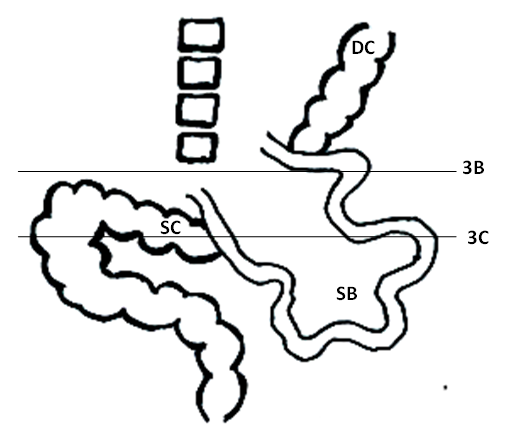
Figure 3A A diaphragm shows a condition which may mimic transmesocolic hernia of the small bowel on axial images. The descending colon lies close to midline and the sigmoid colon shifts to right lower abdomen. The small bowel (SB) then overlies the descending-sigmoid colon to a location posterior and lateral to the sigmoid colon on axial images. The straight lines 3B and 3C represent two levels corresponding to Fig 3B and 3C.
Identification of a transmesocolic hernia of the small bowel on CT needs recognition of not only a characteristic location of the small bowel which is posterior and lateral to the sigmoid colon, but also the abnormal course of the herniated small bowel and the associated vessels which should be dorsal to the sigmoid colon. A similar location of the small bowel on axial images without hernia may be seen in the case of medially displaced descending colon. In that condition, the small bowel and its associated vessels overlie in front of, instead of dorsal to, the descending-sigmoid colon.
None.
Author declares that there is no conflict of interest

©2017 Chou. This is an open access article distributed under the terms of the, which permits unrestricted use, distribution, and build upon your work non-commercially.